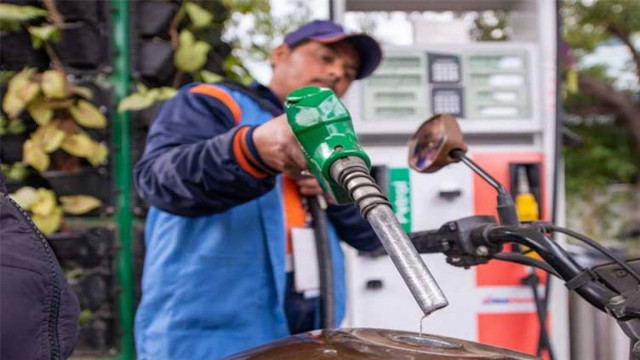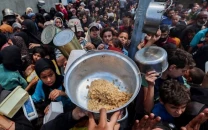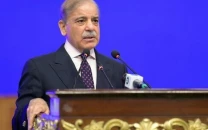Homes hit, businesses reel as energy rates jacked up
Residential gas prices up 67%; subsidy to fertiliser plants goes; POL process rise up to Rs8.37

The government on Thursday increased gas tariff for residential users by up to 67% and up to 700% hike for fertiliser plants, while jacked up the prices of petroleum products by up to Rs8.37 per liter from Friday (today), in a move aimed at addressing the economic dynamics and ensuring stability in the energy sector.
The federal cabinet, in a meeting chaired by caretaker Prime Minister Anwaarul Haq Kakar, approved the gas price hike to recover additional Rs242 billion from all the consumers, in attempts to bring some equity in the rates of the fast depleting natural asset.
Immediately after the cabinet meeting, the Oil and Gas Regulatory Authority (Ogra) issued notification of the new gas prices, in accordance with the International Monetary Fund’s (IMF) condition of raising the prices by Thursday, February 15.
Just before Thursday midnight, Finance Division notified that the price of MS (petrol) had been increased by Rs2.73 per litre, from Rs272.89 to Rs275.62. Similarly, the price of high speed diesel (HSD) was increased by Rs8.37 per litre, from Rs278.96 per liter to Rs287.33.
The Finance Division said that the decision came in line with the recommendations of Ogra. It added that the adjustment aimed at addressing the current economic dynamics and ensuring the stability of the energy sector in the country.
It was the second time in the past three months that the gas tariff has been increased. The Ogra notification, showed that the hike would take effect from the February 1, and the new bills would be issued with revised rates. The decision puts an unreasonable burden on a class of residential consumers using more than 2 cubic hectometers (Hm3) gas for creating fiscal space to pay subsidies to other domestic consumers.
The cabinet also finally took the much-delayed but needed decision to withdraw the Rs50 billion subsidies to a few fertilisers plants, which were earlier given preferential treatment by robbing the industrial consumers.
Caretaker Finance Minister Dr Shamshad Akhtar played a pivotal role in the withdrawal of the fertiliser plants’ subsidy, although the energy minister was in favour of continuing these subsidies. The fertiliser plants were availing these subsidies without passing on the benefit to the farmers.
The Economic Coordination Committee (ECC) of the cabinet held two rounds to approve these prices and finally took the decision on Wednesday. The federal cabinet ratified the ECC decision of February 14th, reads a statement issued by the Prime Minister’s Office after the cabinet meeting.
It is the third increase in the prices that the consumer would bear amid double-digit inflation. The increase has thrown an additional burden of Rs242 billion on the consumers, including Rs37 billion that the government would earn in sales tax.
It was also the second revision in the gas prices by the caretaker government in the past three months after it earlier increased the prices up to 1108% – the highest for the most vulnerable households.
Residential consumers
The fresh revision also puts maximum burden on the most vulnerable households with a 67% or Rs100 increase per unit for the domestic monthly consumption of 0.5 cubic hectometers (Hm3). For other protected domestic consumers, the increase is in the range of Rs200 to Rs250 – also ranging from 25% to 67%.
The prices for non-protected residential consumers are either now close to the prescribed price of Rs1,597 per mmbtu or even higher than the prices of imported re-gasified liquefied natural gas (RLNG). The rates for 1.5 Hm3 consumers have been increased to Rs1,450 – higher by 21%.
The new prices for the 2 Hm3 monthly consumption consumers are Rs1,900 – up by 19% - and Rs300 more than the cost of gas they need to pay. Similarly for the next slab of 3 Hms consumption, the new rate is Rs3,300 – close to the imported gas rate of Rs3,750.
The two highest residential slabs are charged rates that are even higher than the imported gas prices –Rs3,800 and Rs4,300. They are now forced to pay for the subsidies of other domestic consumers, which is unjustifiable.
Earlier this month, OGRA issued a determination of revised estimated revenue requirements (RERR) for FY 2023-24 for both the SNGPL and the SSGCL. According to the revised determination, the SNGPL requires a revenue of Rs592 billion and the SSGCL requires a revenue of Rs310 billion this fiscal year, the total revenue requirement has been determined at Rs902 billion, arriving at an average prescribed price of Rs1,596 per mmbtu.
The residential consumers of housing societies that buy gas in bulk will face a 45% increase in their prices. Their new rate is Rs2,900 – up by Rs900 compared to current rates that too are just three months old.
The fresh increase in prices is expected to further fuel the inflation that remains far higher than the goal set by the central bank. The inflation rate in January remained at 28.4% as against the annual target of 21%.
Industrial Consumers
The cabinet approved further increase in the gas prices for the in-house power generation of the industries for both the export and non-export sectors. Going forward, the cabinet has ended the distinction of the export and non-export and a new uniformed rate for in-house gas plants has been set.
The cabinet approved increase in the captive plants rates from Rs2,200 to 2,750 for exporters and from Rs2,500 to 2,750 for local production – an increase, ranging from 10% to 25%. The Petroleum Division had proposed Rs2,950 per mmbtu rate, which was opposed by the industry minister.
The Pakistan Textile Exporters Association (PTEA) Pattern-in-Chief Khurram Mukhtar emphasised the need for negotiating sustainable energy tariffs with the IMF and rationalising cross subsidies on industrial energy tariffs to support growth.
“Just raising energy tariffs is not going to work; strict enforcement requires reducing T&D losses and full bills recovery,” said Mukhtar. “Current hike in gas and electricity tariffs is disastrous for the economy and lacks any wisdom,” he added.
Fertiliser plants
The caretaker cabinet has taken some corrective measures to stop the misuse of subsidy by the fertiliser plants. These plants were availing subsidised gas but were still selling expensive urea to the farmers.
The cabinet approved increase in the feed gas prices for Engro Fertiliser from Rs200 to Rs1,597 per mmbtu –a surge of 700% that ends Rs39 billion subsidies. The effective date for revised gas tariff for Engro Fertiliser is 1st March, 2024.
It also approved increase in gas prices for Fauji Fertiliser Bin Qasim Limited (FFBQL) from Rs580 to Rs1,597 mmbtu, showing an increase of 175% and ending its Rs10 billion subsidy.
Agritech and Fatima Fertiliser are currently getting RLNG from SNGPL network. The cabinet approved increasing their prices by 29% to Rs1,597 per mmbtu, which is the average prescribed price in case these plants are offered system gas on SNGPL.
The government still has to increase the gas prices for those fertiliser plants, which are availing the gas from the Mari Gas network.
For the CNG sector, the government has increased the prices from Rs3,600 per mmbtu to Rs3,750 per mmbtu equivalent to the RLNG price being the fuel for majority CNG producers in the country.


















COMMENTS
Comments are moderated and generally will be posted if they are on-topic and not abusive.
For more information, please see our Comments FAQ